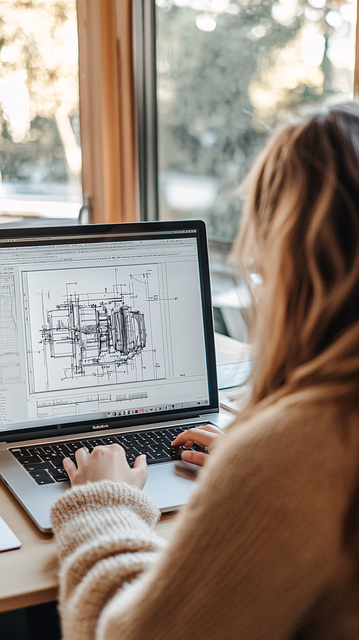Residential architectural drafting blends eco-conscious design with energy efficiency to create sustainable buildings. By using natural materials like bamboo and recycled steel, optimizing light and insulation, and integrating green spaces, it minimizes the carbon footprint while enhancing occupant health and comfort. These strategies, from passive cooling to renewable energy sources, position residential architectural drafting as a key driver in the global shift towards greener living environments.
“Discover the future of construction with sustainable architecture drafting – a revolutionary approach to eco-friendly building design. This comprehensive guide explores key principles that define this green movement, from energy efficiency in residential spaces to integrating natural elements seamlessly. We delve into the selection and application of eco-conscious materials, offering innovative solutions for architects and builders. Embrace a new era of residential architectural drafting, where design meets environmental stewardship.”
Understanding Sustainable Architecture Principles
Sustainable architecture is a holistic approach to building design, focusing on minimizing environmental impact and maximizing resource efficiency. At its core, it involves understanding and applying principles that promote harmony between buildings and their natural surroundings. Key principles include energy efficiency through passive design strategies, like proper orientation for sunlight and cross-ventilation, as well as the use of renewable energy sources.
Eco-friendly building designs also emphasize material choices—selecting locally sourced, recycled, or sustainable materials reduces a structure’s carbon footprint. Residential architectural drafting plays a pivotal role here, translating these principles into practical, aesthetically pleasing homes. Drafters ensure that buildings are designed not just to meet sustainability goals but also to enhance the well-being of their occupants while preserving the surrounding ecosystem.
Eco-Friendly Materials and Their Applications
Eco-friendly materials are at the heart of sustainable architecture, revolutionizing the way we build and design. In residential architectural drafting, natural, renewable options like bamboo, straw bale, and recycled steel or glass are gaining traction as viable alternatives to traditional construction materials. These materials not only reduce a building’s environmental impact but also offer unique aesthetic appeal, creating living spaces that are both harmonious with nature and visually striking.
Their applications vary widely, from structural framing to insulation and finishing touches. For instance, bamboo, known for its strength and rapid growth rate, can be used in floor and wall framing, while recycled steel is ideal for durable and sustainable roofing. Straw bale walls provide excellent insulation, reducing energy consumption, and recycled glass can add a touch of modern elegance to windows and exterior cladding. This shift towards eco-friendly materials promises not only a greener future but also offers homeowners unique, sustainable design options in residential architectural drafting.
Energy Efficiency in Residential Design
In residential architectural drafting, energy efficiency is a cornerstone of eco-friendly building designs. By integrating smart design principles and sustainable materials, architects can create homes that optimize natural light, reduce heat transfer, and minimize the need for artificial heating and cooling systems. This not only lowers residents’ utility bills but also significantly reduces the building’s carbon footprint. Techniques such as proper insulation, high-performance windows, and energy-efficient appliances play a vital role in making residential spaces more sustainable.
Residential architectural drafting can further enhance energy efficiency through thoughtful placement of buildings on plots, incorporating green roofs or walls, and integrating renewable energy sources like solar panels. These strategies not only contribute to the overall aesthetic appeal of the property but also ensure that homes remain comfortable and cost-effective to live in throughout the year. This approach to residential architectural drafting is a key driver in the global shift towards more sustainable living environments.
Integrating Green Spaces into Building Layouts
Integrating green spaces into building layouts is a key strategy in sustainable architecture, offering both aesthetic and functional benefits for residential architectural drafting. By incorporating gardens, courtyards, or rooftop vegetation, designers can create vibrant outdoor areas that enhance the overall well-being of occupants while promoting environmental sustainability. Green spaces serve as natural buffers against urban heat islands, improving indoor air quality and providing insulation during extreme weather conditions.
In residential architectural drafting, these features can be tailored to suit diverse needs, from private gardens offering a tranquil retreat for residents to shared community greenspaces that foster social interaction. Careful planning ensures that green spaces are seamlessly integrated into the building design, enhancing the connection between indoor and outdoor living areas and contributing to the overall energy efficiency and eco-friendliness of the structure.
Sustainable architecture, driven by principles of eco-friendly design and materials, is no longer a niche concept but a necessity for modern residential architectural drafting. By integrating energy-efficient features, utilizing sustainable materials, and strategically incorporating green spaces, architects can create buildings that minimize environmental impact while enhancing occupant comfort and well-being. Embracing these practices not only contributes to a greener planet but also ensures the long-term viability and value of residential properties in an increasingly conscious world.
